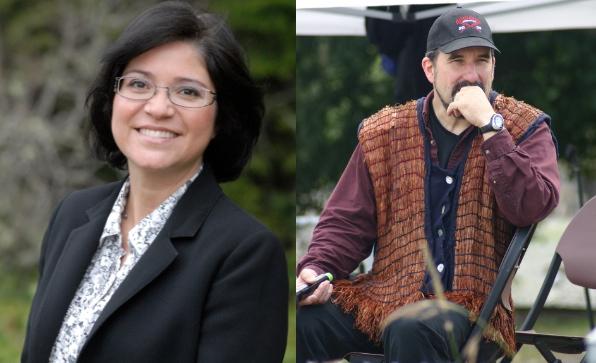
Maia Bellon, left, Mescalero Apache, was appointed director of the state Department of Ecology by Gov. Jay Inslee; Leonard Forsman, Suquamish Tribe chairman was appointed by President Barack Obama to the federal Advisory Council on Historic Preservation.
Read more at https://indiancountrytodaymedianetwork.com/2013/05/29/3-washington-native-leaders-quinault-adviser-named-key-positions-149581
Richard Walker, Indian Country Today Media Network
Two Native Americans in Washington state and an environmental adviser to Quinault Nation’s president were named in May to key positions influencing the arts, the environment and historical protection. Earlier, an environmental lawyer who is Mescalero Apache was named director of the state’s Department of Ecology.
Suquamish Tribe Chairman Leonard Forsman was appointed by President Barack Obama to the federal Advisory Council on Historic Preservation. Forsman said he will continue to serve as Suquamish chairman; the advisory council meets quarterly and members are not paid.
The Advisory Council on Historic Preservation (ACHP)is an independent federal agency that promotes “the preservation, enhancement, and productive use of our nation’s historic resources,” and advises the President and Congress on national historic preservation policy.
According to the agency’s website, “The goal of the National Historic Preservation Act, which established the ACHP in 1966, is to have federal agencies act as responsible stewards of our nation’s resources when their actions affect historic properties. The ACHP is the only entity with the legal responsibility to encourage federal agencies to factor historic preservation into federal project requirements.”
Forsman has been chairman of the Suquamish Tribe since 2005. He earned a bachelor of arts in anthropology from the University of Washington and a master of arts in historic preservation from Goucher College.
Forsman was director of the Suquamish Museum from 1984 to 1990, and has served on the museum Board of Directors since 2010. He was a research archaeologist for Larson Anthropological/Archaeological Services in Seattle from 1992 to 2003. He has served on the Tribal Leaders Congress on Education since 2005, the Suquamish Tribal Cultural Cooperative Committee since 2006, the Washington State Historical Society board since 2007, and was vice president of the Washington Indian Gaming Association in 2010. He also served on the state Committee on Geographic Names.
Forsman said, “I want to build on the advisory council’s efforts to recognize and protect those cultural resources that are important to tribes — the cultural landscape and sacred places that have been neglected — and provide tribes more resources to protect those places to the best of our ability.”
Maia D. Bellon, Mescalero Apache, was appointed director of the state Department of Ecology by Gov. Jay Inslee. Several Olympia insiders say Bellon may be the first Native American appointed to a cabinet-level position by a governor of Washington.
Upon taking office, she helped resolve a dispute that threatened a cleanup plan for an old mill site on Port Gamble Bay, one of seven bays identified as cleanup priorities under the Puget Sound Initiative.
Ecology wants two old docks with creosoted pilings removed as part of the cleanup; the mill site owner, Pope Resources, wanted to keep the docks in place until it had approval for a new dock, which it considers critical to its plans to further develop its upland community of Port Gamble.
The final agreement puts the docks’ removal later in the cleanup timeline. Pope has no guarantee it will get a new dock, but it may be able to use removal of the old docks as mitigation when it applies for a new-dock permit; in other words, Pope could say the environmental impacts from the new dock would be offset by the removal of the old docks.
Bellon’s handling of the negotiations won praise. “In her first weeks in office, [she] brought a focused effort on reaching an equitable resolution to this complex cleanup project,” Pope president and CEO David Nunes said.
Bellon is the daughter of Richard Bellon, executive director of the Chehalis Tribe; and Rio Lara-Bellon, a writer and educator. She graduated from The Evergreen State College in 1991 and Arizona State University Law School in 1994.
In the ensuing years, she served as an environmental attorney with Ecology and the state Attorney General’s office. In 2011, she became manager of Ecology’s water resources program, responsible for management of the state’s water resources, the allocation of water, and protection of water rights, instream flows and environmental functions.
In that role, she shepherded an agreement ensuring sufficient stream flows for salmon without jeopardizing local water-use rights in the Dungeness River basin. Among its many provisions, the agreement established necessary stream flows for salmon habitat, and set up a “water bank” through which land owners can buy, sell or lease water-use credits, or water rights.
Bellon said she works to help all sides see the other’s perspective and keep everyone focused on shared goals. “I strive to serve as a bridge,” Bellon said. “When people are in the same room, when they’re engaged closely, they find they share many of the same values. That’s where we need to start.”
Tracy Rector, Seminole/Choctaw, was appointed by Seattle’s mayor and City Council to the Seattle Arts Commission.
Rector is executive director of Longhouse Media, which works to break down negative stereotypes of Native people in the media, and help Native youth develop the skills necessary to tell their own stories through digital media. She produced the award-winning film, “March Point” (2008), a coming-of-age story about three Swinomish teens who make a documentary about the impact of two oil refineries on their community.
Rector’s film work has been featured at the Cannes Film Festival, ImagineNative Film + Media Arts Festival, the Smithsonian’s Museum of the American Indian, and on PBS’s Independent Lens. She has a master’s in education from Antioch University.
Gary Morishima, natural resources adviser to Quinault Nation President Fawn Sharp, is a new member of the U.S. Geological Survey Climate Change and Natural Resources Science Committee, and the U.S. Fish and Wildlife Service Native American Policy Team. He was appointed by U.S. Interior Secretary Sally Jewell.
In her announcement, Jewell said the climate change committee will work to “develop sound science that will help inform policymakers, land managers and the public in making important resource management decisions.”
Morishima said in an announcement released by the Quinault Nation, “Because Tribal communities are place-based and critically dependent on natural resources, they are among the most vulnerable to climate impacts and among the most experienced in adapting to changing conditions. Tribal perspectives need to be an integral part of the committee’s dialogue. Awareness and respect for both tribal wisdom and western science will be crucial to our collective ability to understand, confront and overcome the scientific, economic and political challenges that lie ahead.”
Morishima said of his appointment to U.S. Fish and Wildlife’s Native American Policy team, “It’s a big responsibility and an exciting opportunity to strengthen working partnerships to care for the land and people.”
Morishima has an undergraduate degree in mathematics and a Ph.D. in quantitative science and environmental management from the University of Washington. He has served the Quinault Nation since 1974 in forestry, fisheries and natural resources management. He has testified before Congress on natural resource management, trust reform, and Indian policy. He is one of the founders of the Intertribal Timber Council.
“I am very proud of the many achievements and contributions Dr. Morishima has made in his 40 years of service to the Quinault Nation and to Indian country,” Quinault’s president said in the announcement. “I have full confidence that he will do an exceptional job and that his efforts will make a substantial difference in meeting the challenges being addressed by these two important committees.”
Read more at https://indiancountrytodaymedianetwork.com/2013/05/29/3-washington-native-leaders-quinault-adviser-named-key-positions-149581












